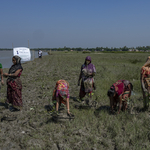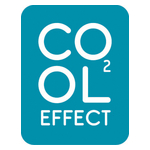SAN FRANCISCO–(BUSINESS WIRE)–As the voluntary carbon market continues to see exponential growth, an important aspect of carbon project quality is how projects create social benefits beyond emission reductions – that is, how carbon finance transforms a local community. This is what Cool Effect calls The Good on the Ground.
Transformational community impacts include livelihood improvements, benefits to healthcare, sanitation, infrastructure, educational programs and more. These impacts are often monitored and then verified during the verification process using assessment procedures from an outside organization such as Climate Community and Biodiversity (CCB), Gold Standard or the Verra SDG (Sustainable Development Goal) Vista program. Often benefits are categorized according to the 17 different United Nations Sustainability Goals (UNSDGs) and then listed in project documentation along with supporting evidence. These social benefits are an important aspect of all Cool Effect credits, so we like to see for ourselves just how things are working by making a site visit.
Last Fall, co-founder Dee Lawrence traveled to India and Indonesia to get a first-hand look at some carbon-reducing projects in the region, with two purposes in mind: 1) to monitor and ensure that a project Cool Effect already supports is ultimately doing what it says, and 2) to vet and consider adding new projects to Cool Effect’s portfolio. These visits are a learning and life changing experience.
For Peat’s Sake (Sampit, Indonesia)
Dee knew before her visit to The Katingan Mentaya Project in Indonesia (home to For Peat’s Sake on Cool Effect’s platform) that the impact of carbon finance on this region and its people was significant, but once there, the magnitude of the benefits sank in. The entire project really runs on water; the canals and channels and rivers encircling this 157,000 hectares of the peat swamp ecosystem are a lifeline to the surrounding communities. The swamp had been undisturbed for thousands of years and serves as a home to primates such as orangutans, birds, insects and mammals including the spotted leopard. Before the project area was set aside for conservation it was intended to become an acacia plantation, which would have then been regularly clear-cut to make paper.
While visiting, Dee was able to spend time with Mr. Dharsono Hartono, the CEO of Rimba Makmur Utama, one of two partners in the Katingan Mentaya Project. Hartono had the vision for a carbon credit project that protected an important ecosystem while bringing benefits to the 32 local communities surrounding the project area. For the project to be successful, buy-in from communities was essential and Hartono made it his goal to connect and spend time with each and every one. Meanwhile he worked for more than 2 years to secure the essential government licenses to protect the land and later brought in as a partner Permian Global to add additional resources to the project development.
Dharsono has made good on his early connections, and today, communities enjoy a secure understanding of land boundaries and 7 project managers work with communities to help them decide how best to deploy the resources they receive from the sale of carbon credits. Project management has secured connections to valuable markets for high value agricultural products. It has also identified a potential source of enormous income well-suited to the project area and is in the process of building a solar facility to deliver reliable electricity to off grid communities.
Peat can burn easily, especially during drought periods in the swamp. So fighting forest fires in the project has been important. To protect the carbon credits from being turned into smoke, the project now employs 600 community firefighters. But livelihoods are key so the project has also helped support mother and small child health clinics, reforested degraded areas, and provided alternative work growing seedlings and test plants for illegal loggers and poachers. During her visit, Dee learned that one of the former illegal loggers is now tasked with protecting, preserving, and populating large portions of the very same forest he used to cut down.
The project has a microfinance program to support small business development. Project employees shared a story about how initially, local men took the lead on managing the program, and after a few logistical and operational hiccups, they were quickly pushed out of their positions by local women. Since this peaceful exchange of power, these women have done a stellar job ramping this program up to over 1000 microfinance loans to help community members set up household-based micro businesses. Without the support of these incredible community members, the project would not be as successful as it is today.
Fertile Ground (Delhi, India)
Four years ago, nearly every farmer in northwestern Delhi rid their fields or the leftover rice stubble the same old fashioned way: by burning it. This practice released CO2 into the atmosphere along with smoke and particulates that made existing pollution from millions of automobiles and coal fired power plants even worse. Now, thanks to the work of a carbon project, Fertile Ground, farm workers turn their rice stalks into earth, storing carbon in the soil instead of the atmosphere. Not burning has benefits for breathing and vision. More importantly, it brings modern farming techniques to traditional farmers, saving them labor, and water and nourishes the soil.
The heat from burning fields kills positive microbes, bacteria and fungi and other life in the soil such as earthworms that make soil fertile and more resistant to disease. It incinerates some of the carbon in the soil. And, burning stubble burns valuable nutrients the plant residue has taken from the soil. When stubble is turned under it decays into a mulch that helps retain moisture and nourish the dirt, providing increased crop yields and a declining need for fertilizer.
The project is also finding a way to pay farmers for what was previously wasted and left to decompose. Now after the harvest, the leftover stalks are collected, sometimes baled, and then turned into compost, or shipped to energy facilities for generation of electricity using biomass. Still, the rice harvest process is labor intensive and manual. Stalks are cut by hand and bundled by men and women alike. Dee was astonished by the remarkable strength of local women, who carry rice stalk bundles of 60 or 70 lbs on their heads.
Paradise Island (Sundarbans, India)
Sundarbans, India is home to the single largest population of Bengal tigers in the world. But when Dee visited the region, what most impressed her was how locals were working to grow, manage and preserve the fragile mangrove ecosystem. Sundarbans is frequently threatened by tropical storms, which cause flooding, wind damage, and crop destruction. By growing and restoring mangrove trees along the coastline, residents are able to use these trees as a natural barrier against the worst effects of storms. While the mangrove trees take carbon out of the atmosphere, the funds generated from carbon credits are providing much-needed development in the region.
Because this is an early stage project, investment funds are being used to pay local residents for help with planting and the establishment of a 300,000 seedling nursery. Local residents are paid to collect high quality, sorted “Propagules” or mangrove seeds.
When sales of carbon credits are made (expected by 2025), funds will be used to support education: a small primary school plans to expand the number of grades to better-serve local students. Mangrove Honey is a treasured product from the region; the project intends to help label and reach new markets for the honey. The area has its share of tourists – around 500,000 people visit each year to take in the beauty of the landscape and hope to catch sight of a Bengal tiger. The project enlists help, know-how and management from local residents. One local businessman, Anil, a former tiger poacher, now has turned his attention to ensuring long term survival of his community, helps manage and identify suitable locations for mangrove plots and promotes eco-tourism.
Much like the roots of the mangrove tree, The Good On The Ground from quality carbon projects can help anchor, protect, and empower the people and places who need it most.
In the last year, the Cool Effect team has collectively visited over twenty carbon projects around the globe, encountering stories of people who are stewards of the planet and their communities. Projects like For Peat’s Sake, Paradise Island, and Fertile Ground are the epitome of The Good on the Ground. The commitment to robust quantification of carbon and verification means that the planet benefits, and their appreciation of The Good on the Ground means that people benefit as well.
To learn more about Cool Effect or how to partner with the organization to develop a meaningful sustainability and carbon offset program, please visit cooleffect.org/for-business.
About Cool EffectTM
Cool Effect is a San Francisco Bay Area 501(c)(3) nonprofit dedicated to reducing carbon emissions around the world. Endorsed by 1% for the Planet, its mission is to educate and then inspire businesses and individuals to take measurable action against climate change by purchasing scientifically verified carbon offsets from the world’s highest quality projects. It returns more than 90% of each donation directly to its project partners and, since its launch at the Paris COP in 2015, has helped projects receive compensation for three million tonnes of emission reductions. Like the Butterfly Effect, The Ripple Effect, and others, a single action can have global impact. To learn more, please visit cooleffect.org or follow Cool Effect on Facebook, Instagram, LinkedIn and Twitter.
Contacts
Jenn Eiskamp
Demonstrate PR on behalf of Cool Effect
[email protected]
415.400.4214








